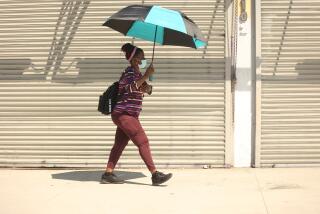How to Sweat Safely When Exercising in Summer Heat
- Share via
When temperatures skyrocket, Jon Marmor’s exercise fever drops. “If it’s really hot and difficult to breathe, I postpone exercise until late in the day,” says the 33-year-old UCLA newsletter editor, who walks six miles every day and then swims half a mile. “Sometimes, I just take the day off.”
Summer’s dog days are the perfect excuse for couch potatoes to stay put. But for exercise fanatics, the challenge is to know how to sweat safely.
*If you’re just beginning to exercise regularly, work out early in the morning or late in the day, advises John Duncan, an exercise physiologist at the Institute for Aerobics Research in Dallas.
*If you’re changing your indoor routine to outdoors during the balmy summer months, cut back 50% of what you normally do for two to three weeks, Duncan cautions, even if you’re an experienced exerciser.
*When deciding whether to exercise or not, don’t take temperature alone into account, Duncan advises. Consider humidity and pollution too. When high ozone levels trigger a first-stage smog alert, most people will experience troubling symptoms such as coughing, shortness of breathe and chest tightness. “I advise people to let your body tell you when to stop,” says Dr. Henry Gong, director of UCLA’s Environmental Exposure Laboratory, who notes the peak ozone levels usually occur from noon to 4 p.m. “If you start feeling tightness in your chest, for instance, you should stop.”
*Drink, a lot. Dehydration is a very real danger, especially outdoors. How much to drink? An hour before exercising, drink 16 ounces of liquid, advises Bill Fink, a exercise physiologist at Ball State University’s Human Performance Laboratory. During exercise, drink about 6 ounces every 15 to 30 minutes. After the workout, drink more than you need to feel content. “The exact numbers aren’t as important as remembering to keep drinking,” Fink says.
*Consider new wet and cool exercises. Hydro-tone, a water weight system that includes hand-held Hydro-Bells and Hydro-Boots for the feet, amplifies water’s resistance to movement. “Twenty minutes in the pool equals an hour in the weight room,” claims Jim Millican, a manufacturer’s representative. Exer-Swim is a tether-like loop introduced nationally this summer by Connecticut-based Lane Gainer. “It’s like swimming against the resistance of a rubber band, so exercisers can swim in place with a slight forward movement,” Lane Gainer’s president Craig Askins says.
Water workouts can have a double whammy benefit for travelers. “A sure cure for jet lag is to get into water,” says Lynda Huey, a Santa Monica water exercise expert.
Microwaved Fowl
Too hot to cook, try the microwave. But don’t try chicken. Microwaved chickens can routinely contain live salmonella, the bacteria responsible for food poisoning.
In a Georgia Southern College study, dietitian Bonnie Fields injected 18 chicken breasts with salmonella. She cooked half in conventional ovens and half in microwave ovens. Eight of nine microwaved breasts contained live salmonella, but all the conventionally cooked chicken were salmonella free. Salmonella easily survive in microwaved chickens, Fields says, because the surface of the food--where salmonella lurk--doesn’t get hot enough to kill the bacteria in microwaves that cook food from the inside out.
What to do?
“Keep chicken out of the microwave,” Fields advises, knowing that not everyone will heed that advice. “If you must microwave chicken,” she pleads, “put it in a sealed cooking bag or enclose it in plastic wrap so steam is created. Then there’s a better chance of killing the bacteria because the temperature rises high enough.”
Microwave cooking can be safe if you’re patient. “Be sure the juices from chicken run clear with no trace of pink,” advises Betty Waldner, a dietitian with the Los Angeles County Department of Health Services: “And turn the chicken frequently.”
Susan Templin, home economist with the U.S. Department of Agriculture’s Meat and Poultry Hotline, advises paying attention to the chicken’s temperature: “At an internal temperature of 160 degrees Fahrenheit, poultry is considered to be safe from salmonella, but it won’t be considered done until it’s cooked to an internal temperature of 180 degrees Fahrenheit.”


